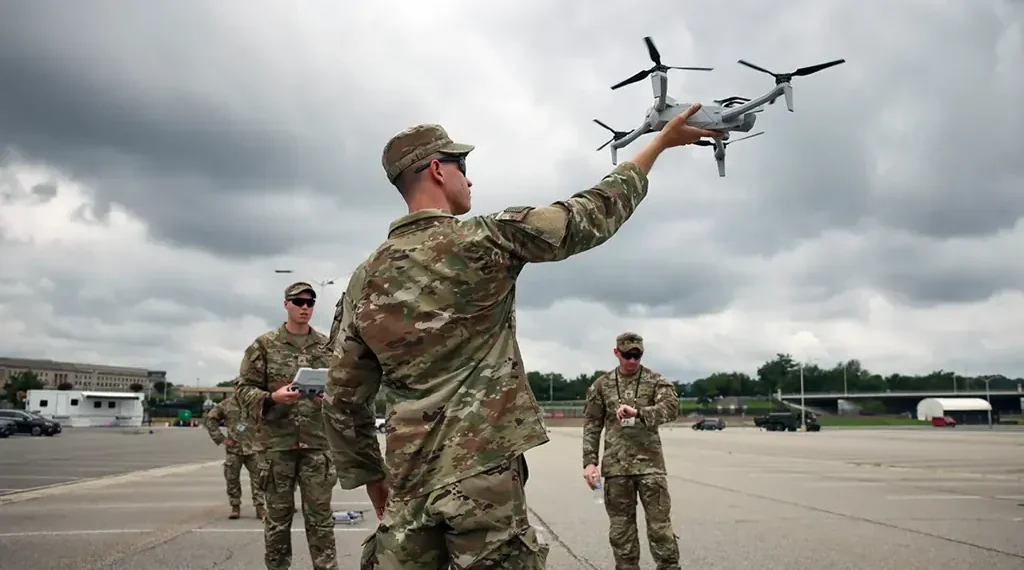U.S. Army Expands AI Training and Counter-Drone Defenses With Smart Glasses, Laser Weapons, and 25-Brigade Overhaul in Modernization Push
Published Time: 09-22-2025, 14:30 EDT
The U.S. Army is rapidly expanding its use of artificial intelligence (AI) in both training and battlefield operations, signaling a significant shift in how the service plans to defend against emerging threats. Senior leaders say the counter-drone mission is now the nation’s top tactical priority, while modernization efforts are reshaping how soldiers train, fight, and adapt on future battlefields.
AI-Enabled Glasses for Training in the Field
Army Secretary Dan Driscoll confirmed this week that soldiers are testing AI-powered Ray-Ban smart glasses designed to assist in field maintenance. The pilot program allows experienced mechanics to record repair procedures, which the glasses then use to guide less-experienced troops through complex tasks, such as infantry squad vehicle repairs.
Driscoll emphasized the Army’s new strategy of adopting consumer technology more quickly rather than relying solely on traditional defense industry development cycles. While the commercial version of the glasses cost billions to develop, the Army’s pilot program uses models priced at roughly $400 per pair.
“This reflects our push to bring proven technology into the force at speed and scale,” Driscoll told reporters, noting the efficiency gains in training and readiness.
Counter-Drone Warfare Declared the Nation’s “Problem 1A”
Alongside training innovations, Army leaders stressed that counter-drone defense is now among the military’s most urgent challenges.
“This is problem 1A that we’re facing as a country,” Driscoll said, warning that swarms of low-cost drones present a threat that human operators alone cannot manage. He underscored the need for defensive systems that are affordable, automated, and capable of scaling to meet evolving adversary tactics.
Army Chief of Staff Gen. Randy George echoed that assessment, pointing out the cost imbalance between drones and the systems used to intercept them.
“If you’ve got a $5,000 drone, you want a $2,000 or $3,000 interceptor — not a $50,000 solution,” George said.
The urgency of the issue has been highlighted overseas. Last week, Dutch F-35s and Polish F-16s were deployed to intercept dozens of Russian drones, underscoring the widespread use of inexpensive unmanned systems in modern conflicts.
Testing Lasers, Proximity Rounds, and Civilian Airspace Defenses
The Army is currently evaluating proximity rounds and high-energy lasers as potential tools for counter-drone defense. However, leaders noted that protecting civilian airspace presents additional challenges, given the need to differentiate between commercial aircraft and potential threats.
George said the Army must adapt quickly: “Our systems need to be reliable in crowded skies, not just combat zones.”
Modernizing 25 Brigades in Two Years
As part of its broader continuous transformation initiative, the Army plans to overhaul 25 brigades within the next two years. The goal is to improve mobility, lethality, and survivability in high-threat environments.
The first armored brigade combat teams will rotate through the National Training Center in California this November, followed by a major joint exercise in Hawaii.
George also confirmed that the Army’s next-generation M1E3 tank could begin arriving in units as early as next year. The lighter and faster platform is intended to replace the decades-old Abrams, and its early fielding represents a dramatic acceleration from prior projections, which suggested the 2030s.
Funding Shifts and Support for Innovation
To finance this modernization drive, Driscoll said the Army will cut $48 billion over five years from programs deemed no longer essential, redirecting resources toward drones, air defenses, and long-range strike capabilities.
In addition, the Army has launched a $750 million “Fuse” fund to support small and mid-sized businesses in defense innovation. The fund aims to foster rapid prototyping and more agile acquisition practices.
At next month’s Association of the U.S. Army (AUSA) conference, leaders plan to announce new reforms designed to streamline collaboration between soldiers, engineers, and contractors — a model inspired by commercial technology firms.
Building American-Made Drones and Using 3D Printing
Officials also highlighted in-house efforts to bolster production and logistics. George said Army depots are now manufacturing drones entirely with U.S.-sourced components, including models already deployed in Ukraine. This approach is designed to secure supply chains and replenish stockpiles.
Meanwhile, Driscoll confirmed that 3D printing is being tested to overcome logistical hurdles in the Indo-Pacific region. Soldiers could use mobile printers to fabricate replacement parts in theater rather than waiting on extended supply lines, improving resilience in contested environments.
Transforming Battlefield Command
Another priority is reshaping battlefield command structures. The 4th Infantry Division is currently testing ruggedized tablets running command-and-control applications, which may replace the bulky trucks and racks of radios that traditionally anchor command posts.
The shift is intended to make headquarters more mobile and less vulnerable to enemy targeting. However, defense analysts have cautioned that the adoption of commercial-style devices could expose the Army to cybersecurity and durability challenges in combat environments.
Political Backing and Future Outlook
Driscoll credited President Donald Trump with supporting the Army’s transformation agenda, noting consistent approval for tough funding decisions. However, he acknowledged that proposed budget cuts face resistance from both Congress and defense industry stakeholders who benefit from legacy programs.
“Every cut has defenders, but modernization is essential,” Driscoll said.
Conclusion
The Army’s current initiatives highlight a decisive shift toward integrating AI, accelerating modernization, and preparing for the challenges of drone warfare. From AI-enabled glasses in training fields to laser-based air defenses, leaders say the service is committed to leveraging innovation to stay ahead of adversaries.
With 25 brigades set for overhaul, billions in redirected funding, and new technologies reaching the field faster than ever, the Army is signaling that its modernization efforts are not just long-term goals but immediate priorities.
This article was rewritten by JournosNews.com based on verified reporting from trusted sources. The content has been independently reviewed, fact-checked, and edited for accuracy, neutrality, tone, and global readability in accordance with Google News and AdSense standards.
All opinions, quotes, or statements from contributors, experts, or sourced organizations do not necessarily reflect the views of JournosNews.com. JournosNews.com maintains full editorial independence from any external funders, sponsors, or organizations.
Stay informed with JournosNews.com — your trusted source for verified global reporting and in-depth analysis. Follow us on Google News, BlueSky, and X for real-time updates.













